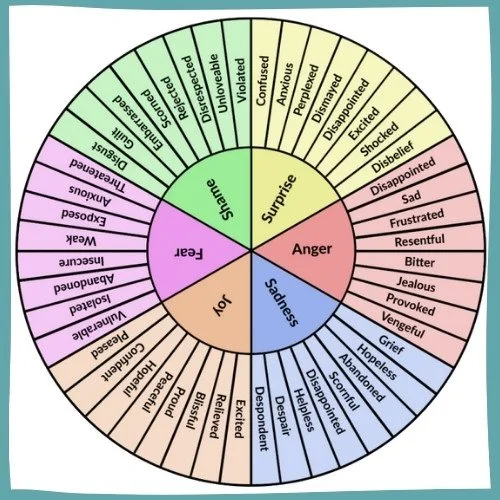Most people are used to describing their emotions as general, vague concepts.
For example:
“I feel upset.” “Upset” isn’t an emotion, it’s a generalization.
“I’m about to explode!” Does this mean you’re excited or angry? Again, this is a generalization, and a hyperbole.
In order to find the root cause of your emotions, it’s necessary to find the root emotion you’re feeling.
The outer circle of emotions is how we tend to describe what we’re feeling. These are the secondary emotions.
The inner circle contains primary emotions. These are the main emotions that all secondary emotions stem from.
This wheel can help you to figure out which of the primary emotions you’re feeling. Until you understand the primary emotion, you may struggle to figure out what’s causing you to feel what you’re feeling.
The easiest way I know to figure out why you’re feeling an emotion is to drill down using the question, “why?”
I’m giving you permission to act like a two-year old.
Let’s try an example.
Mom: “Why did you slam the door?”
Daughter: “Because I’m upset!”
Mom: “Why are you upset?”
Daughter: “Because I tore my jacket!”
Mom: “Well, it can be fixed. Why are you so upset?”
Daughter: “I feel so stupid! I should have been more careful!”
Mom: “Okay. You weren’t being careful. I still don’t understand why you’re so upset about this.”
Daughter: “Because Gram bought me this jacket! What’s she going to think?! I’ve only had it for three days and I’ve already ruined it!”
Mom: “Ah. So, you feel embarrassed that you weren’t being careful?“
Daughter: [Tearful] “But she warned me to take good care of it and I didn’t listen!”
Mom: “Oh honey. I think you feel ashamed of your behaviour. What were you doing when it tore?”
Daughter: [Bursts into tears] “Climbing a tree!”
In this example, the mother recognizes that her daughter is feeling a strong emotion that doesn’t, at first, seem to fit the situation. This is a clue that she needs to help her daughter drill down to figure out the issue that’s truly causing the emotion. Only then can they really deal with it.
Note: If you consult the wheel above, you’ll notice that embarrassment is a secondary emotion to shame.
What could have happened?
What could have happened if the mother simply reacted to her daughter’s behavior instead of paying attention to her emotional state?
Mom: “Why did you slam the door?”
Daughter: “Because I’m upset!”
Mom: “We don’t slam doors in this house! Go to your room until you’re ready to be civil!”
Daughter: “Ugh! You’re the worst mother in the world!”

Family discussion: Treating strong emotions with empathy
As a family, try to recall the last time one of you was showing strong emotion. Practice drilling down together to try to find the root cause of the emotion.
Make a promise to each other that you’ll try to practice empathy instead of getting angry in response to someone’s behavior. This might take practice. Even if at first, you react in anger to someone’s outburst, try drilling down after everyone has calmed down. If you practice this enough, it will become habit.
